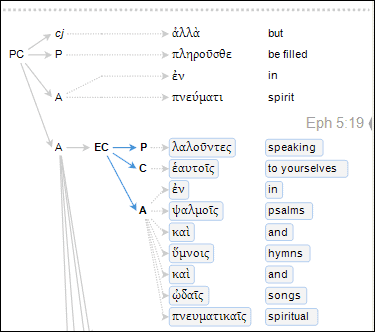In previous blog posts, I’ve focused on how the syntax databases we offer are used when searching, when asking questions of the text. But this is not the only use. I don’t even know if it will end up being the primary use. I was reminded about this with a recent comment on one of my posts:
These blogs are extremely helpful for things like [structure searching], but make it difficult for an average joe like me to get a search result and have confidence that all the cases of what I’m looking for would be covered. . .I’d think “what kind of clause component will this show up in that I’ll miss with this search”. Certainly, I’ll get some results I’d want, but will I get them all?
Instead of focusing more on searching, I figured I’d step back and show another use that doesn’t require any searching knowledge at all. Just being able to see the structure of the text in a different way is helpful when reading through the text.
We read through the text in translations with paragraphs/etc frequently. Reading through a syntax graph
Ephesians 5.18b-21 offers a good example. I’ll give you two hints: Look only at the clauses (primary and embedded) and the verbs in those clauses, and the relationship between these things. No searching necessary. Just reading slowly paying attention to the annotated syntax.
And there’s a video (Flash, 3 megs, with sound) that provides a little more information to help in seeing how this can be done.
Here’s Eph 5.18b-21 in the ESV, just plain text. Read it in this form and try to think about the underlying structure of the text:
18 And do not get drunk with wine, for that is debauchery, but be filled with the Spirit, 19 addressing one another in psalms and hymns and spiritual songs, singing and making melody to the Lord with all your heart, 20 giving thanks always and for everything to God the Father in the name of our Lord Jesus Christ, 21 submitting to one another out of reverence for Christ. (Eph 5.18-21, ESV)
What can we see from just looking at the syntax here? Check out the video for more explanation, but in short, you’ll see how to:
- View only clause information in your graph, removing some of the word group annotation since we’re just looking at clause level data here
- Find verbs in the annotation
- Show why this is relevant when looking at the annotation for Ephesians 5.18b-21 (which is a whole primary clause)
Update: If you’re interested in using the Lexham Syntactic Greek New Testament to assist as you’re reading through the text, check out this post from May 2006. It’s a handy way to work through the Greek text of, say, First John and beef up your knowledge of the syntactic goings-on at the same time!
Update II: Note that I’ve blogged again about how reading the syntax graph can help when analyzing or outlining a particular passage: Organizing an Outline with Syntax Graphs.





